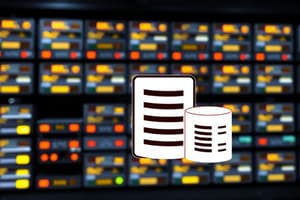Podcast
Questions and Answers
What is another common name for a flat file database?
What is another common name for a flat file database?
- Relational database
- Hierarchical database
- Object-oriented database
- Text database (correct)
Which organization is credited with the development of flat file databases, and in what decade did this occur?
Which organization is credited with the development of flat file databases, and in what decade did this occur?
- IBM in the 1970s (correct)
- Microsoft in the 1980s
- Google in the 2000s
- Oracle in the 1990s
How are records typically separated within a flat file database?
How are records typically separated within a flat file database?
- Using delimiters such as tabs and commas (correct)
- Using complex encryption algorithms
- By embedding XML tags
- Through predefined data structures
What is generally considered a primary advantage of using a flat-file database?
What is generally considered a primary advantage of using a flat-file database?
Which of the following is a noted disadvantage of flat-file databases when compared to more sophisticated database systems?
Which of the following is a noted disadvantage of flat-file databases when compared to more sophisticated database systems?
For which type of tasks are flat file databases typically considered unsuitable?
For which type of tasks are flat file databases typically considered unsuitable?
What issue concerning data management is more prevalent in flat file databases compared to DBMS?
What issue concerning data management is more prevalent in flat file databases compared to DBMS?
What functionality is typically a strength of DBMS but a limitation in flat file systems?
What functionality is typically a strength of DBMS but a limitation in flat file systems?
Which type of business is more likely to utilize a flat file system over a DBMS?
Which type of business is more likely to utilize a flat file system over a DBMS?
What is a key characteristic that distinguishes DBMS from flat file systems regarding data integrity?
What is a key characteristic that distinguishes DBMS from flat file systems regarding data integrity?
What is a primary function of a Database Management System (DBMS)?
What is a primary function of a Database Management System (DBMS)?
What core capability does a DBMS provide regarding data accessibility and security?
What core capability does a DBMS provide regarding data accessibility and security?
What fundamental aspect of data handling is a key benefit of using a DBMS?
What fundamental aspect of data handling is a key benefit of using a DBMS?
How do network databases differ from hierarchical databases in structure?
How do network databases differ from hierarchical databases in structure?
In object-oriented databases, what is a key feature that encapsulates both data and procedures?
In object-oriented databases, what is a key feature that encapsulates both data and procedures?
What characteristic is unique to cloud databases compared to traditional databases?
What characteristic is unique to cloud databases compared to traditional databases?
Which of the following is an example of a cloud platform used for cloud databases?
Which of the following is an example of a cloud platform used for cloud databases?
What setup defines a centralized database?
What setup defines a centralized database?
What is the defining characteristic of a NoSQL database?
What is the defining characteristic of a NoSQL database?
In the context of database systems, what does the acronym 'NoSQL' originally stand for?
In the context of database systems, what does the acronym 'NoSQL' originally stand for?
Flashcards
Flat File Database
Flat File Database
A database stored as a single file, easy to understand and sort.
DBMS
DBMS
A software system to efficiently manage and organize data in a structured manner.
Cloud Database
Cloud Database
A database used for virtual data storage and execution, with cloud computing services for access.
Centralized Database
Centralized Database
Signup and view all the flashcards
NoSQL Database
NoSQL Database
Signup and view all the flashcards
Flat file database record
Flat file database record
Signup and view all the flashcards
Flat file database origin
Flat file database origin
Signup and view all the flashcards
Flat file database storage
Flat file database storage
Signup and view all the flashcards
Disadvantage of Flat file database
Disadvantage of Flat file database
Signup and view all the flashcards
Disadvantage of Flat file database
Disadvantage of Flat file database
Signup and view all the flashcards
Disadvantage of Flat file database
Disadvantage of Flat file database
Signup and view all the flashcards
Study Notes
- Flat file databases are also known as text databases
- They are a common database type used for storing data in plain text files like MS Excel
- IBM developed the first flat file databases in the early 1970s
- In flat file databases, each line of the plain text file corresponds to one record
- Records are separated by the use of delimiters, such as tabs and commas
- Flat-file databases are easy to understand and sort
Flat File Database: Pros
- All records are stored in a single place
- They can be easily understood and configured
- It is an excellent option for small databases
- They require less hardware and software components
Flat File Database: Cons
- Updating is more difficult
- Changing data format is more difficult
- Poor performance with complex queries
- Increased redundancy and inconsistency
Flat File System vs DBMS
- DBMS supports multi-user access, flat file systems do not
- DBMS is used by both small and large businesses, flat file systems are typically used by small businesses
- DBMS has no redundancy and integrity issues, flat file systems do
- DBMS is more expensive than flat file systems
- DBMS is able to work with complicated transactions, flat file systems cannot
Database Management Systems (DBMS)
- Designed to manage and organize data in a structured manner
- It allows users to create, modify and query, while also managing security and access controls
- Provides an environment to efficiently store and retrieve data
Types of Databases
- Hierarchical
- Network
- Object-oriented
- Relational
- Cloud
- Centralized
- Operational
- NoSQL
Cloud Databases
- Used where data requires a virtual environment for storing and executing over cloud platforms
- There are many cloud computing services for accessing data from cloud databases
- Examples of cloud platforms include: Amazon Web Services (AWS), Google Cloud Platform (GCP), Microsoft Azure, and ScienceSoft
NoSQL Databases
- NoSQL databases are non-relational
- They provide a mechanism for storage and retrieval of data
- These databases model data using means other than the tabular relations used in relational databases
Studying That Suits You
Use AI to generate personalized quizzes and flashcards to suit your learning preferences.




